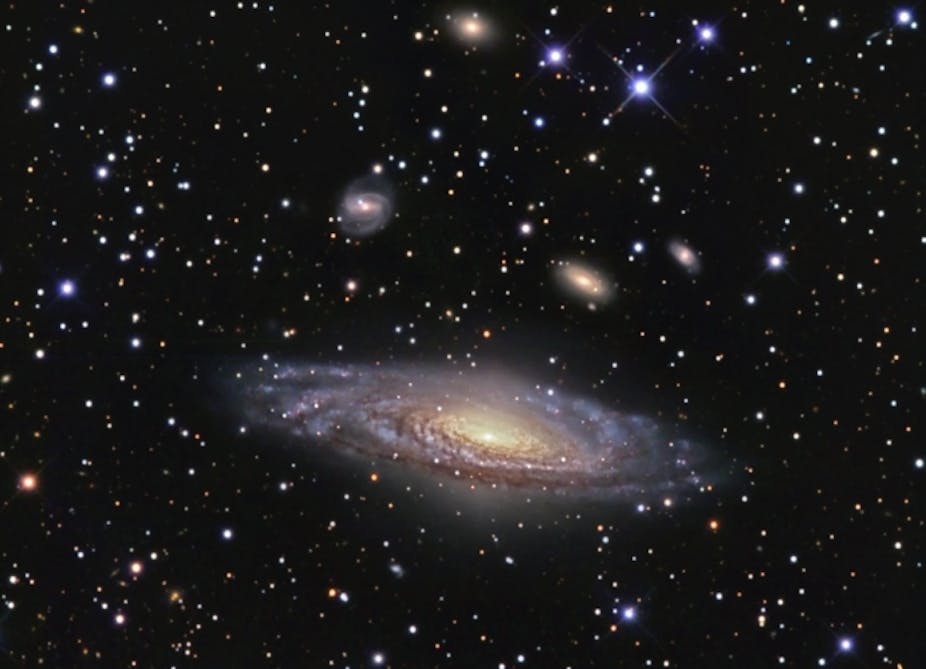Where are we within our galaxy? How did our galaxy form? How did it evolve over the aeons?
Astronomers have been asking these questions for the past century, and have recently begun discerning the answers.
Home sweet home
Our galaxy is one of billions in the universe, each of which in turn contains billions of stars.
We live roughly half way between the centre and edge of our galaxy, known as the Milky Way.
Our galaxy is so vast that light, moving at 300,000 kilometres a second, takes 26,000 years to travel the distance between us and the centre of the galaxy.
The Milky Way is one of many spiral galaxies in the Universe, and from a great distance it may look like NGC 7331. Our home is in the disk of the galaxy, not far from one of the spiral arms.
From our vantage point here on Earth, the structure of our galaxy isn’t obvious, which isn’t surprising. Trying to see it would be like trying to photograph the exterior of your house from the living room.
But if we look at the night sky we can see the disk of our galaxy as a band of stars stretching from horizon to horizon. We can also see an abundance of stars in the constellation Sagittarius, where the centre of our galaxy lies.
But our galaxy is not comprised of stars alone.
Dark matter
Perhaps the most mysterious component is dark matter. In the 1970s, astronomer Vera Rubin and her colleagues measured the motion of stars in nearby galaxies. This motion is too fast to be explained by the gravity of the stars and gas that we can directly observe.
In order to explain this discrepancy, it’s believed a vast amount of unobserved dark matter must be present not just in our galaxy but throughout the universe.
Origins and Evolution
So how do galaxies form?
Dark matter interacts with itself and conventional matter largely via gravity. And with only one force to consider, simulations of the behaviour of dark matter are actually simpler than simulations of conventional matter. This means we can simulate the birth of galaxies.
To do this, we set up a grid of particles, switch on gravity and let the simulation rip. As illustrated in a simulation by Andrey Kravstov and Anatoly Klypin, dark matter rapidly collapses under the influence of gravity to form structures.
And it’s within these structures, known as dark matter halos, that galaxies are born.
Where do stars come from?
The gas in an early universe also feels gravity’s pull and undergoes gravitational collapse. The gas can lose energy by radiating light and can collapse further than the dark matter.
As a consequence, gas can collapse into objects sufficiently dense for nuclear fusion to take place, creating stars. This process began perhaps a few hundred million years after the Big Bang, and continues to this day.
New stars are being formed in the constellation Orion, and with binoculars we can see the gas illuminated by the newly formed stars.
But, while astronomers agree on this picture of galaxy formation, major details are missing. Do galaxies grow largely via forming new stars, or does most of the growth occur via mergers of galaxies?
Do galaxies grow rapidly when the universe is young, or have they been gradually built up over billions of years? Why do some galaxies continue to form stars, while other galaxies do not?
Peering into the past
A time machine would be an ideal tool for answering these questions: we could view the universe throughout its history, seeing how galaxies such as our own form and grow.
Luckily enough, such time machines are available. Telescopes allow us to peer into the past. Because the speed of light is finite, we see distant objects as they were, not as they are; and the further we look, the further we look into the past.
With Hubble Space Telescope, Spitzer Space Telescope and giant telescopes on Earth, astronomers have been able to view much of the history of the universe.
Images from Hubble reveal thousand of galaxies, many billions of light years away, in just a tiny patch of the night sky.
Connecting these snapshots into a coherent history is a challenge for astronomers. We are not watching individual galaxies over the course of time, but taking samples of populations separated by billions of years of history.
New telescopes and instruments will revolutionise the field in the coming decade, and Australia will play a leading role.
HERMES, a new instrument for the Anglo-Australian telescope, will survey the stars of the Milky Way with unprecedented precision.
Australia is also a partner in the Giant Magellan Telescope, a leviathan that will utilise seven mirrors that are 8-metres in diameter. This telescope will provide views of the distant universe with detail greater than Hubble.
The Australian Square Kilometre Array Pathfinder, now under construction in Western Australia, will identify galaxies vigorously forming stars when the universe was young.
Question will remain, but in the coming decade astronomers may well answer the big questions about the origin and evolution of our home galaxy, the Milky Way.

